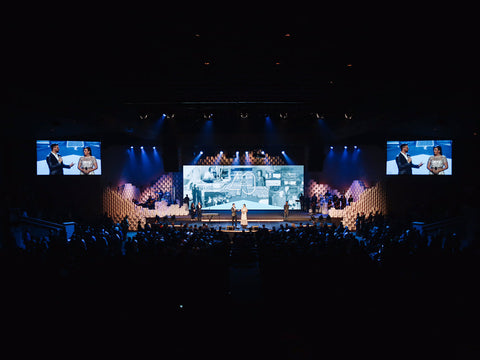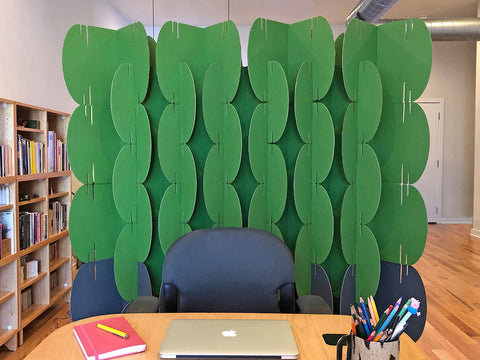Posted by Alex Frazer, MIO Culture Trade Support
Trade shows are great for marketing your products, networking with industry professionals, and engaging with potential customers. But they aren’t just social events. Your decision to attend a trade show should be a calculated one – one where you weigh the preparation and financial investment with the potential outcomes.
Ideally, you’ll leave the trade show with constructive feedback, strategic partnerships, and new customers. But with hundreds of other businesses vying for a limited amount of attention, these ideal outcomes won’t happen without careful planning and execution.
In addition to your brand itself, the booth is the most important part of your trade show experience. It must accurately represent your company and stand out amongst the other exhibits, so the design is critical.
However, many first time vendors cut corners when designing and building their booths to save money (trade shows aren’t cheap). They believe that their products and personalities will be enough to attract guests to their space. They couldn’t be more wrong.
So if you’re planning to design and build your first trade show booth, here are a few things you should know.
[products ids="nomad-system-room-dividers, nomad-system-felt-acoustic-room-dividers"]
Why are trade show booths important?
Trade shows are an opportunity for industry leaders to display, demonstrate, and explore the latest products and services in a particular niche. And the best way to make the most of your trade show experience is with an eye-catching booth.
 They’re the best way to showcase your brand, meet potential customers, build relationships, and so much more. Your booth is an extension of your business, so it’s important that it accurately reflects your brand. It will also be the first thing that people notice, so it’s important to make a great first impression. After that, it’s up to you to market your products the “old-fashioned” way, by talking to people.
They’re the best way to showcase your brand, meet potential customers, build relationships, and so much more. Your booth is an extension of your business, so it’s important that it accurately reflects your brand. It will also be the first thing that people notice, so it’s important to make a great first impression. After that, it’s up to you to market your products the “old-fashioned” way, by talking to people.
So how do you set up your trade show booth for success? We’re going to walk you through how to design a booth that commands the attention of the busy exhibition floor.
What are the most common trade show booth setups?
Your display will largely be dictated by the type and location of your booth in the expo or convention center. Here are the most common types of setups:
Inline booth
Inline booths are aligned in rows, with booths on either side and behind them. They’re the most common setup at trade shows because they’re simple and enable event organizers to maximize the amount of displays. And because they’re the most common, they are often the least expensive option for vendors.
As a vendor, you only have to focus on the aisle directly in front of you, allowing you to capture the attention of passing attendees. However, inline booths do have their drawbacks – it can be hard to stand out among neighboring booths without an eye-catching display.
Perimeter booth
Peninsula booths are similar to inline booths with the only difference being that they’re backed up against a wall. So though you’re still surrounded by other brands, you can use the height of the wall to your advantage. With the added benefit of having a stable wall, perimeter booths tend to cost a bit more than inline booths.
Peninsula booth
Peninsula booths are located at the ends of inline rows. And as the name suggests, you’ll have three sides of exposure to the walkway, increasing your visibility among attendees. The added size and flexibility provides more room to display products and speak with potential customers and meet future business partners. And with added size comes a bigger investment.
Island booth
Island booths are open on all sides, making them the most visible option at crowded trade shows. With maximum exposure, island booths offer the most flexibility and size, allowing you to play with various designs and product layouts. These are the most coveted spots at trade shows and organizers know it – expect to pay accordingly.
Other things to consider when designing your booth
In addition to the size and location, the building materials, graphics, and lighting will affect how you design your booth and market your products.

Which materials to use, how to transport it, and unexpected event fees
Building your display
Many trade shows don’t permit the use of power tools inside the building. So if you were planning on constructing your display walls on-site, you may have to reconsider. Most vendors opt for modular displays because they can quickly be set up without the need for tools.
And they’re much lighter to carry, which makes setup and tear-down a much easier process. Try using materials like wood, fabric, plastic, or cardboard dividers.
Shipping and transportation
Modular displays also pack flat for transportation, reducing the size and weight of the package. This will help you save money on shipping and freight charges, especially if the event is multiple states away or even in another country. And if you’re transporting it yourself, it will be much easier to pack the modules into the van or trailer.
Drayage fees and material handling
Drayage fees account for the movement of your products and display from the delivery vehicle to your booth space. It’s often an unexpected fee for first-time vendors that can set you back several thousand dollars without warning. Make sure to double check with event coordinators and adjust your budget accordingly.
Banners, Pop-Ups, and Posters
As great as your products are, they won’t sell themselves. But the right visual displays will. And how you choose to use banners, pop-ups, posters, or printed merchandise will determine how you plan to interact with attendees.

Interacting with guests
Trade shows are noisy environments, which make it difficult to speak with potential customers and other business leaders. And unfortunately, every booth type has this issue.
The close proximity of inline and perimeter booths force crowds to overlap and conversations to carry further than intended. The elevated foot traffic near peninsula and island booths also creates elevated noise levels with hundreds of passing conversations occurring right next to your display. You can block out these sounds with acoustic display panels to create visual and acoustic privacy even in such a busy space.
How to design a trade show booth that stands out
Businesses are competing for the attention of attendees and investors. And your booth is their first impression of your brand – it’s important to design a layout that’s both eye-catching and functional. Here are a few tips to get you started.

Use clear, concise messaging
You only have 8 seconds to capture someone’s attention – make them count. Write impactful headlines in large fonts that can be read from a distance. These will attract interested parties to your booth where you can answer questions and showcase your products.
The headlines will draw them to your booth, but your logo will make the lasting impression. Make sure to place your logo and brand name in multiple areas around your space.
And lastly, make sure to place important headlines and logos at or above eye level. With constant foot traffic, you don’t want your messaging to get lost in the crowd.
Keep it consistent
Brand consistency creates trust. That means banners, images, and giveaways have to be branded with the same fonts, logos, and colors. And because it takes the average person five to seven times seeing a logo to remember your company, consistent branding makes it all the more important.
Play with negative space
With such a small space to display your products, you may feel the need to cram everything into your booth – don’t. Nothing is more unattractive than excess inventory and minimal floor space. These make it difficult to interact with your audience and they’ll likely pass right by your booth to avoid awkward spacing and conversations. Keep the floor space open so that multiple parties can engage with your booth without feeling packed in.
Make it interactive
Informational videos and slide presentations may seem like the best way to educate your audience. But you may bore them instead. Interact with visitors by playing games or giving away promotional gifts that promote engagement and attract larger crowds. As your crowd grows, so too does the number of potential customers. And as a bonus, you’ll have the chance to get direct feedback from a wider demographic.
Control the acoustics in your booth
Constant foot traffic and neighboring vendors make it difficult to communicate with customers. You may feel like you have to raise your voice to speak or lean in closely to hear what they’re saying, but this is a futile attempt.
But you can control the acoustics in your booth and reduce unwanted noise from the rest of the event using portable soundproofing dividers. These absorb excess sound and improve speech clarity in and around your booth. And because they easily slide across the floor, you can quickly adjust your booth for acoustic or aesthetic reasons.
Make your booth stand out with color, pattern and great acoustics. And you’ll be in good company, the best brands in the world trust MIO for their trade show displays:

Think outside the exhibition box
You paid for a square or a rectangular booth but that doesn't mean you’re confined to those shapes alone. Consider which sides will get the most attention based on the flow of traffic, large attractions, and entryways and exits.
Can certain products and displays be positioned on the diagonal? Which side should be the “front” of the booth? Is there room to give product demonstrations? These are all questions you should ask yourself before you start setting up. And most events provide a booth map days before it begins, so you’ll have plenty of time to figure this out.
Experiment with different colors and textures
Most exhibitors stick to neutral color palettes – this is fine if it matches your brand and product tone. But if your brand has a colorful side, a booth is a great place to showcase that personality. Experimenting with different colors, accents, and textures will naturally attract attendees to your booth. If you’re looking for a new color scheme, consider how your choice will influence potential customers:
-
Red - associated with strength, power, and love. It stands out in a crowd and has been shown to increase blood pressure when viewed.
-
Blue - a popular color that embodies trust, loyalty, and productivity. Contrary to red, it has a calming effect and has been shown to decrease blood pressure when viewed.
-
Green - aligned with nature and symbolizes sustainability, creativity, and safety. Green is often associated with displays that focus on the planet and human health.
-
Yellow - indicates happiness and energy. And much like the sun, it has a warming effect which attracts nearby attendees.
-
Purple - an often underutilized color, purple represents luxury and mystery, which is an effective marketing tool for high-quality products.
Tell a story
Your booth should tell a story. Use your branding, displays, and products to provoke the emotions of your audience. Think of the entryways and large banners as the beginning of your story, setting the stage for them. And then through your products, demonstration areas, and discussions, further captivate them to form a connection with your brand.
Do your research
Search online for last year's show and see what your competitors did with their booth. Search for other shows and see what they are doing in other industries. Is there something that you can do that will showcase your company and products in a new light. This research can inform everything you do to stand apart and make a solid pitch. From the colors of the booth and its location to the size of the walls and logos.
What to expect at your first trade show
Preparing for your first trade show is incredibly exciting. It’s your chance to showcase your products and brand to customers, business partners, and industry leaders. They’re also a big investment, so you want to make a great impression. Here are a few tips to ease your nerves.
Come prepared
Trade shows can be intense, energy-draining events – you need to be prepared at every moment. Your next big deal could come to life at your next conversation or product presentation. Sleep well the night before, eat a healthy breakfast, and show up early to set up your display. If your show or exhibition is only a few days, you want to make every minute count.
Bring a reusable water bottle and some quick snacks to sustain your energy. These will help you make it through long days on your feet and constant conversations. And don’t forget that it’s a long day for visitors too – giving away candy or mints will go a long way in making a lasting impression on the audience.
Create a checklist of all the items you need to bring, from pens and business cards to staplers and catalogs. Setting up shows can be a monumental task, but you can remove some of the burden and stress by planning and visualizing how the setup and event will unfold.
When are trade show booths busiest?
The peak hours at a trade show vary based on the size, industry, and dates of the event. But generally, here’s what you can expect.
-
Attendees tend to show up earlier on weekdays but later in the day on weekends.
-
The first 30 minutes are usually slow, especially at bigger shows. The best way to avoid slow periods is by designing a booth that’s impossible to ignore, keep this in mind.
-
The first few days are usually busier than the last few days.
-
Corporate attendees usually show up during business hours on weekdays whereas smaller organizations will show up towards the end of business days or on the weekend.
-
Breakfast hours and lunch hours are usually the slowest so try to sneak in your snacks and restroom breaks during these times.
How many booths on average do trade show attendees visit?
For smaller shows with less than 500 exhibitors, attendees will likely walk through the entire show. But a smaller event doesn’t mean fewer sales and connections. These shows often focus on a particular niche that attracts more engaged visitors.
On the other hand, attendees at larger shows will rarely walk through the entire event, especially if it spreads across multiple convention center halls or even entire cities. As a result, you may only interact with a few hundred of the thousands of visitors. If you want to interact with more people, a well-designed booth is a great place to stand out.
Regardless of event size, the quality of visitors is far more important than the quantity of visitors. It’s better to interact with 100 interested customers than 1000 unqualified buyers. If they’re interested, make sure you exchange contact information and follow up promptly. They may not buy right away but with a bit of persistence, they’ll eventually become a loyal customer.
Whether you’re a first time exhibitor or seasoned veteran, there’s always ways to improve your trade show booth design. You can upgrade the acoustics, change the branding and color scheme, or experiment with a new layout altogether. Eventually, you’ll figure out what works for your business and which approach helps you reach your goals.





